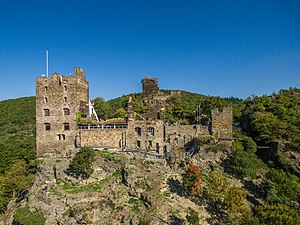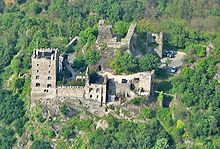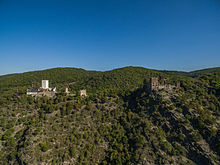Liebenstein Castle (Rhine Valley)
| Liebenstein Castle | ||
|---|---|---|
|
Liebenstein Castle, 2015 |
||
| Alternative name (s): | Levenstein | |
| Creation time : | around 1284 | |
| Castle type : | Hilltop castle | |
| Conservation status: | Shield wall, Bergfriedrest, residential tower | |
| Place: | Kamp-Bornhofen | |
| Geographical location | 50 ° 12 '44.3 " N , 7 ° 38' 7.6" E | |
| Height: | 230 m above sea level NHN | |
|
|
||
Liebenstein Castle , also called Levenstein , is the ruin of a hilltop castle . Together with Sterrenberg Castle, 200 meters away, the castle forms the so-called " enemy brothers " on the right bank of the Rhine near Kamp-Bornhofen in the Middle Rhine Valley in Rhineland-Palatinate . The Rheinsteig hiking trail on the right bank of the Rhine leads over Liebenstein Castle. From there there is a good view of the Rhine Valley with Bad Salzig .
Liebenstein Castle has been part of the Upper Middle Rhine Valley UNESCO World Heritage Site since 2002 ; it is also a protected cultural asset under the Hague Convention . Liebenstein Castle is the highest castle on the Middle Rhine.
history

The castle was probably built in the 13th century as a bailey to Sterrenberg Castle. Both castles were fiefs of the Lords of Bolanden (later Sponheim-Dannenfels ). Albrecht von Löwenstein, husband of the Luccardis von Bolanden, had this outer bailey expanded from 1284 to 1290 against their uncle Werner VI. from Bolanden to Sterrenberg Castle, who wanted to dispute this property with his niece.
In 1294 the castle had to be sold to the knights Siegfried Schenk von Sterrenberg and Ludwig von Sterrenberg, based in the neighboring castle. These were now called "von Liebenstein". While Sterrenberg Castle was taken by Kurtrier , Liebenstein Castle remained in family ownership as a Ganerbeburg . Further extensions were made (1363 gate tower , around 1380 defense tower ). The main residential tower was also built in the 14th or 15th century. In the period that followed, up to ten hereditary parties lived in the castle, all of whom built their own defense towers and residential buildings. This structure can still be seen today.
In the 14th century Kurtrier built the second shield wall on Sterrenberg Castle as a so-called "battle wall ", probably directed against Liebenstein Castle - this is the historical core of the legend of the "Enemy Brothers".
In 1529 the castle was so dilapidated that it was uninhabitable. Franz Friedrich von Liebenstein, court master, senior bailiff and supreme commander of the city and castle of Saarbrücken , who was buried in the collegiate church of Sankt Arnual in Osterspai in 1596 after his death, is one of the most important fiefs . In 1637, after the Liebensteiners died out, it passed to the Kurmainz Chancellor Gerhard von Waldenburg . As Karl Frhr. v. Waldenburg called Schenkern remained childless, Georg Ernst Ludwig von Preuschen von und zu Liebenstein , "Princely Oranien-Nassauer secret council and district president" of Dillenburg , was enfeoffed in 1783 by the Princely House of Nassau with the Imperial Liebenstein Castle and the village of Osterspai . Rudolf Frhr. von Preuschen von und zu Liebenstein had extensive restoration work carried out in 1977 and 1978. The main residential tower and its extension are now used as a restaurant and hotel.
legend
There are several versions of the legend of the “ enemy brothers ”. What is certain is that there never was an argument with weapons. The legend is the subject of the poem Zwei Brüder by Heinrich Heine in the Book of Songs .
Today's plant
You enter the castle, accessible via a narrow, steep driveway with only a few parking spaces in front of the entrance, from the south; to the west (on the Rhine side) the remains of a defensive tower have been preserved, to the east the ruins of a smaller residential tower (privately owned), surrounded by a massive mantle wall.
The dominant building is the 17 meter high residential tower from the 14th or 15th century on the north side of the complex, to which a gabled house was added in the 17th or 18th century. The tower has an almost square floor plan and seven floors. This complex now houses the restaurant with castle garden and viewing terrace, as well as the hotel with rooms facing the Rhine, newly furnished in the 21st century with period furniture .
In the interior of the castle, an accessible slate rock protrudes from the center, on which the ruins of the rectangular keep rises.
Walls with a ditch in front and a small remnant of another residential tower delimit the castle courtyard on the Rhine side. In the Middle Ages, there was also a wall and moat to protect the neighboring castle. The remains of a gun emplacement can be found in front of the north wall.
swell
- ↑ The enemy brothers: Liebenstein and Sterrenberg in the magazine of the Kölner Stadt-Anzeiger, p. 8, 2./3. April 2011
- Winfried Monschauer: Liebenstein Castle via Kamp-Bornhofen . 1st edition. Rhenish Association for Monument Preservation and Landscape Protection, Cologne 2008, ISBN 978-3-86526-028-4 , ( Rheinische Kunststätten issue 506).
- Alexander Thon, Manfred Czerwinski: The most beautiful castles in Germany . Part 2: Middle Rhine Valley from Rüdesheim to Bonn . CD-ROM. Superior, Kaiserslautern 2003, ISBN 3-936216-08-8 .
Web links
- Website of the castle hotel
- Interactive 3D models of the castle at Sketchfab and Altizure
- Entry by Reinhard Friedrich zu Liebenstein am Rhein in the scientific database " EBIDAT " of the European Castle Institute
- Enemy brothers at "World Heritage Upper Middle Rhine Valley"
- Reconstruction drawing by Wolfgang Braun






